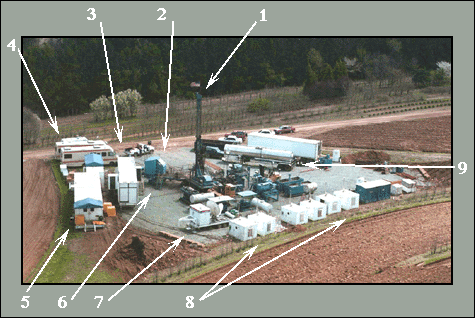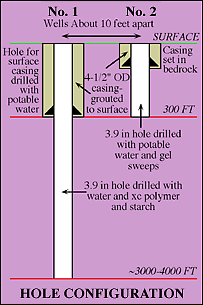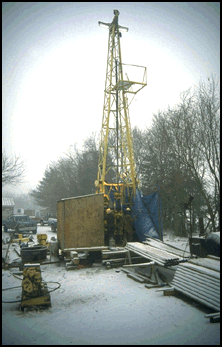
 Using the offset drilling method, the core holes were spudded in or just above a specific , easily recognized mapped lithostratigraphic unit or member and continuously cored from the base of a 90 m cased interval through to another distinctive member at a depth of about 1 km, which was in turn the target to spud into for the next stratigraphically lower core interval. This procedure was followed for the entire section, although not necessarily in stratigraphic order due to logistical constraints. At 5 of the 7 sites, to comply with New Jersey environmental guidelines and meet our coring objectives, it was necessary to drill an additional hole to recover the upper ~90 m represented by the cased interval in the immediately adjacent main hole (see Goldberg and others, 1994). We refer to the deeper core hole as no. 1 and the 90 m core hole as no. 2 (go to cores). Details of the drilling procedure as well as descriptions of the various logs acquired in the core holes are described in Goldberg and others (1994). Two groups were involved in the coring itself: Amoco Production company's SHADS operation and Longyear Drilling.
Using the offset drilling method, the core holes were spudded in or just above a specific , easily recognized mapped lithostratigraphic unit or member and continuously cored from the base of a 90 m cased interval through to another distinctive member at a depth of about 1 km, which was in turn the target to spud into for the next stratigraphically lower core interval. This procedure was followed for the entire section, although not necessarily in stratigraphic order due to logistical constraints. At 5 of the 7 sites, to comply with New Jersey environmental guidelines and meet our coring objectives, it was necessary to drill an additional hole to recover the upper ~90 m represented by the cased interval in the immediately adjacent main hole (see Goldberg and others, 1994). We refer to the deeper core hole as no. 1 and the 90 m core hole as no. 2 (go to cores). Details of the drilling procedure as well as descriptions of the various logs acquired in the core holes are described in Goldberg and others (1994). Two groups were involved in the coring itself: Amoco Production company's SHADS operation and Longyear Drilling.

The Amoco SHADS coring operation on the Princeton core site.
1, Diamond-bit coring rig with well control and closed circulation drilling fluid system; 2, Control cab for coring rig; 3, Computerized engineering shed for monitoring drilling operations; 4, Mobil homes for housing the Amoco drilling managers and engineers on-site on a 24-hour basis; 5, Geological modules in which core preparation (cutting into 3 ft lengths and boxing) was carried out along with the collection of the core description, digital images, and geophysical measurements; 6, Water well (not visible) for on site drilling water; 7, Satellite dish for voice and telemetric communication; 8, Electrical generators for power; 9, Tanker truck for drilling fluids.
DESCRIPTION
Amoco Production Company's SHADS (Scientific High-speed Advanced Drilling System) was used in a cooperative agreement to core 6 of the 7 Newark Basin Coring Project sites. The cores drilled by Amoco (in the order in which they were drilled) were: Rutgers no. 1 & 2; Somerset no. 1 & 2; Titusville no. 1 & 2; Nursery no. 1; Martinsville no. 1; and Princeton no. 1 & 2. The SHADS operation consisted of a self-contained easily transportable modular system with components listed above. Besides the environmental protection given by the closed drilling fluid and blow out protection systems, the main advantage of the SHADS operation was the on-site geophysical data collected, the most important among are natural gamma radioactivity and magnetic susceptibility. A full description of the coring details and geophysical logs of the cores can be obtained in DOSECC (1994) (go to abstract) and the core geophysical data can also be retrieved on-line. Down-hole geophysical logs were obtained by the Lamont Borehole Research Group who contracted BPB Inc. (go to abstract) (get data).
 The Longyear Drilling Company coring rig at the Weston Canal site.
The Longyear Drilling Company coring rig at the Weston Canal site.
NBCP HOME PAGE
NBCP PROJECT DESCRIPTION
PROJECT LEADERS (P. OLSEN & D. KENT)
BIBLIOGRAPHY AND ABSTRACTS
ON-LINE DATA
CONTINENTAL-SCIENTIFIC-DRILLING
NEWARK BASIN REPORT AT CDS